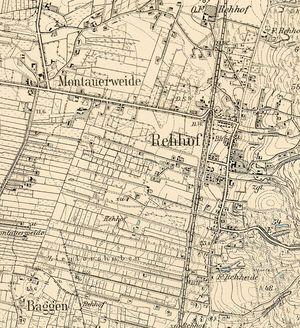Rehhof (Pomeranian Voivodeship, Poland)
Rehhof (also known as Ryjewo Wieś, Ryjow, Reyowo, Regoff, Rehehof, Reehoff, Rehhoff, and Dorf Rehhof; now known as Ryjewo; coordinates: 53.84468, 18.96052 [53° 50′ 40″ N, 18° 57′ 37″ E]; population in 1905, 1,536; in 1939, 2,886; in 2013, 2,914) is located 12.7 kilometres (km) (7.9 miles) north north-east of Kwidzyn (Marienwerder), 21.8 km (13.5 miles) south south-west of Malbork (Marienburg), 30.2 km (18.7 miles) east south-east of Starogard Gdański (Preußisch Stargard), 30.3 km (18.8 miles) south south-east of Tczew, and approximately 62 km (39 miles) south of Gdańsk (Danzig).
Rehhof was established by the 14th century. During the rule of the Teutonic Knights there was a monastic farm here, which burned in 1622. Mennonites settled under a long-term lease in Rehhof in 1742. The northern section of the village included the Oberförsterei Rehhof, a forestry administrative district.
Until 1772 Rehhof was located in what was known as Royal Prussia (also known as Polish Prussia) in the Kingdom of Poland. The First Partition of Poland in 1772 resulted in the creation of a new province on 31 January 1773, called West Prussia, in which the village was located. The village was situated in the district (Kreis) of Stuhm in Regierungsbezirk Marienwerder until the end of World War I, when it came under the jurisdiction of East Prussia. The village came under the control of Nazi Germany during World War II until March 1945, when it was occupied by Soviet forces and returned to Poland. In 2014 Ryjewo was a village in Kwidzyn County, Pomeranian Voivodeship, in northern Poland. It was the seat of the gmina (administrative district) called Gmina Ryjewo.
There were no Mennonite reported in Rehhof in the 1776 census, nor were they any reported in the 1824 census. However, in 1868 the village counted 39 houses, 309 inhabitants, 173 Catholics, 122 Evangelicals and 14 dissidents, most likely Mennonites. The 1935 membership list for the Mennonite church in Tragheimerweide lists the following Mennonite families: Albrecht (2), Bartel (2), Cornelsen, Ediger (2), Goerz, Goertzen, Penner (3), Quiring, Schliffki, Schepansky, Wiens, and Wiebe. Mennonites in Rehhof fled to the West at the end of World War II, thus bringing an end to the Mennonite presence in Rehhof.
Maps
Map:Rehhof, Pomeranian Voivodeship, Poland
Bibliography
Stowarzyszenie Konserwatorów Zabytków. "Ryjewo." Catalogue of Monuments of Dutch Colonization in Poland. 2005. Web. 10 September 2014. http://holland.org.pl/art.php?kat=obiekt&id=530&lang=en.
Wikipedia. "Ryjewo." 1 March 2013. Web. 10 September 2014. https://en.wikipedia.org/wiki/Ryjewo.
Wolf, Hans-Jürgen. "Familienforschung in Westpreußen." Web. 10 September 2014. http://www.westpreussen.de/pages/forschungshilfen/ortsverzeichnis/details.php?ID=5418.
| Author(s) | Richard D Thiessen |
|---|---|
| Date Published | September 2014 |
Cite This Article
MLA style
Thiessen, Richard D. "Rehhof (Pomeranian Voivodeship, Poland)." Global Anabaptist Mennonite Encyclopedia Online. September 2014. Web. 16 Apr 2024. https://gameo.org/index.php?title=Rehhof_(Pomeranian_Voivodeship,_Poland)&oldid=168666.
APA style
Thiessen, Richard D. (September 2014). Rehhof (Pomeranian Voivodeship, Poland). Global Anabaptist Mennonite Encyclopedia Online. Retrieved 16 April 2024, from https://gameo.org/index.php?title=Rehhof_(Pomeranian_Voivodeship,_Poland)&oldid=168666.
©1996-2024 by the Global Anabaptist Mennonite Encyclopedia Online. All rights reserved.

